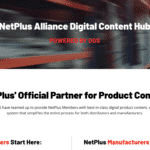Digital transformation has been one of MDM’s key content pillars for at least the past decade, and especially in the post-COVID era as pandemic-accelerated trends in B2B customer buying behavior undoubtedly lit a fire under many distributors and manufacturers to be proactive with innovation.
But amid conversations on this topic, it’s easy to think of large firms as the ones leading the charge when it comes to adding digital tools to their business. That may have been the case initially, as organizations with more than $100 million in annual revenues had the capital to experiment with new tools on the market.
But as the vendor market for Industry 4.0 tools proliferated, price points came down, leading to a lower cost of entry for smaller manufacturers and distributors to get in the game for advanced technology. And given the agility and speed to enact change management that small- and medium-sized business (SMBs) tend to have compared to larger firms, they’ve been able to close the digital gap.
This movement was illustrated in recent research out of advisory firm Wipfli, whose 2024 State of Manufacturing report suggested that smaller manufacturers are having their own digital revolution, rather than just tagging along to what large firms are doing.
In this article, I will highlight some of the interesting findings from that report, and tie in several other research components that align with it.
First, the demographics: Wipli surveyed 335 U.S.-based manufacturers during August 2023 — 59% of which indicated having annual revenues of no more than $100 million, with 33% at no more than $50 million. The top markets that these companies participate in are machinery manufacturing at 31%; fabricated metal products at 20%; and primary metals; and electrical equipment, appliance and components both at 15%. Nearly half of the respondents indicated their company is privately owned, 36% were private-equity owned, and 17% were publicly traded.
Industry 4.0 Self Assessment
Here’s how respondents chose when asked which description best fit their company’s level of digital maturity/adoption of Industry 4.0 technologies:
- Moderately digitalized – 41%
- Partially implemented – 26%
- In the early stages – 17%
- Fully embraced – 10%
- Not digitalized at all – 5%
Areas of Digital Investment
71% of respondents indicated they plan to increase their Industry 4.0 investments during 2024. Here’s what their top picks were for which technologies they currently use:
- Cloud computing – 62%
- Data analytics/business intelligence – 60%
- ERP – 59%
- Mobile devices – 56%
- CRM – 56%
As for which technologies they plan to invest in, here’s what their top picks were (they could select all that apply):
- Robotics and automation – 50%
- Cloud computing – 47%
- Data analytics/business intelligence – 41%
- AI – 41%
- Production/machine monitoring – 36%
MFG’s Digital Adoption vs. Other Industries
One interesting survey question asked respondents how they think the rate of the manufacturing industry’s digital transformation compares to most other industries. 54% said they believe that rate is either above average or far beyond.
AI
Asked which technologies their company currently uses, only 36% of respondents indicated they are using AI. This nearly matches MDM’s July 2023 research that found only 38% of distributors said they were using AI in any part of their business.
Meanwhile, 41% of Wipfli respondents said they planned to invest in AI over the next 12 months. As for where they plan to apply AI, the top business areas indicated were (they could select all that apply):
- Operations – 70%
- Sales and Growth at 63%
- RPA/Automation at 48%
- Financial Reporting – 47%
- Front/Back Office – 36%
Other Notable Stats from the Survey
- Only 36% of respondents indicated they have encountered barriers to implementing Industry 4.0 technologies. Asked which barriers those are, the top picks were ‘Insufficient technical expertise or workforce training’ at 61% and ‘high costs’ at 54%.
- 90% indicated they have a process improvement strategy in place
- Asked what their annual turnover rate is for front-line employees, 39% of respondents said it’s between 6-10%; 27% said it’s between 1-5%; and 23% said it’s between 11-20%
- Asked what their annual turnover rate is for leadership and management employees, 52% said it’s between 1-5%, while 27% said it’s between 6-10%.
Again, keep in mind that the majority of these survey respondents represent manufacturers with no more than $100 million in annual revenue.
Wipfli Senior Director Mo Abuali, PhD., told MDM these SMB companies are taking advantage of affordable connectivity technology, IT infrastructure and software tools that were once luxuries that only large manufacturers could budget for. He added that smaller manufacturers are able to tap into state funding for technology training and pilot programs.
Val Zanchuk, President of Graphicast — a 25-employee precision metal parts maker in New Hampshire, told the National Association of Manufacturers in 2023:
“Because the cost of data collection and analytics is getting lower and lower, even as a small company we can collect data at a rate that gives us meaningful information we can act upon. For example, we created a linear programming model of our business. If we’re growing at a certain rate, I can use it to determine the most economical next steps, such as whether we should hire more people, work overtime or purchase more equipment.”
Rise of the Midwest
The U.S. Midwest has always been a key region for domestic manufacturing, but isn’t typically thought of as an Industry 4.0 hotbed like the West Coast or northeast. But that perception is changing, Wipfli’s research indicates, as traditionally stagnant small manufacturers there are now embracing innovation.
Wisconsin had the second-best respondent representation of any U.S. state in Wipfli’s survey at 11%, trailing only California’s 14%.
Abuali cited a handful of key reasons why the Midwest is making particularly large strides when it comes to adopting advanced technologies:
- An overall ‘friendly’ atmosphere to live and work in, making it a good place for industrial hubs to attract talent
- Affordability — Lower comparative warehousing, transportation, staffing and living costs mean organizations can drive higher profit margins and improve their bottom line.
- Location — The Midwest offers good transportation infrastructure and accessibility
- Talent — The region is home to numerous top universities and community colleges
Start Small, Then Replicate
I asked Wipfli’s Abuali what his advice would be for fellow SMB manufacturers looking to embrace a digital transition, and here’s what he said:
“Start and strategize your Industry 4.0 journey today. Think big, start small and act now. Then, make your journey operational with a proof of value — a technology pilot with a solid business case. Implement it, and track success. Then, replicate the template out to other plants/processes. Train your internal center of excellence — your champion multi-disciplinary team that can shoulder the strategy and technology conversation and execute the vision. Maintain an Industry 4.0 vision toward zero-downtime/zero-defects, and leverage technologies in an ROI-based fashion to drive value to your external customer and internal users.
“By following this systematic approach, we’ve seen small/mid-size manufacturers achieve significant gains in uptime, quality, throughput, labor efficiency in addition to energy and sustainability improvements.”
SMBs can learn more on this topic by checking out Wipfli’s free Industry 4.0 Rapid Assessment tool.
Related Posts
-
It enables the secure transmission of intellectual property to different locations, ensuring quality assurance and…
-
Member distributors and suppliers can use the hub to access product content from thousands of…
-
It lets Fastenal meet a broader scope of product needs in the aerospace and defense…





